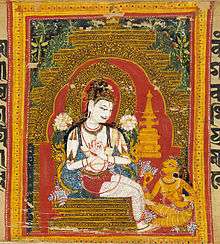Tushita
Tushita or Tusita (Sanskrit: Tuṣita) (meaning "contented" or "joyous")[1] is the fourth of the six deva or heavenly realms of Kamadhatu in Buddhist tradition. It is located between the "Yāmā deva" realm and the "Nirmanarati deva" realm in Buddhist cosmology. Like the other heavens (deva realms), Tusita is said to be reachable through sādhanā, or advanced meditative attainments. It is the heaven where the Bodhisattva Svetaketu (Pali: Setaketu "White Banner") resided before being reborn on Earth as Gautama Buddha, the historical Buddha;[2] it is the place where bodhisattvas, or future Buddhas reside before their rebirth as a Buddha.[3]

Descriptions
Like all heavenly realms in Buddhism, the Tusita Heaven is the residence of divine beings or devas. According to the Visakhuposatha Sutta of the Pāli Canon,[4] time there runs very differently than on Earth:
That which among men is four hundred years, Visakha, is one night and day of the Tusita devas, their month has thirty of those days, their year twelve of those months; the lifespan of the Tusita devas is four thousand of those heavenly years...
Approximately, a deva month would be 12,000 years (four hundred times thirty), a deva year would be 144,000 years (twelve thousand times twelve), and a deva lifespan would be 576,000,000 years (a hundred forty four thousand times four thousand).
According to the Dana Sutta, those who do meritorious deeds with the intention of helping others would tend to be reborn in Tusita Heaven upon death.[5]
Mahayana view
The Infinite Life Sutra, a Mahayana text, states:[6]
Each of these bodhisattvas, following the virtues of the Mahasattva Samantabhadra, is endowed with the immeasurable practices and vows of the Bodhisattva Path, and firmly dwells in all the meritorious deeds. He freely travels in all the ten quarters and employs skillful means of emancipation. He enters the treasury of the Dharma of the Buddhas, and reaches the Other Shore. Throughout the innumerable worlds he attains Enlightenment. First, dwelling in the Tusita Heaven, he proclaims the true Dharma. Having left the heavenly palace, he descends into his mother's womb.
Because Tusita Heaven is where all Bodhisattvas destined to reach full enlightenment in their next life dwell, Tuṣita heaven is therefore closely associated with Maitreya, the next Buddha. Many Buddhists vow to be reborn there so that they can hear the teachings of Maitreya and ultimately be reborn with him when he becomes a Buddha. Other bodhisattvas also dwell in this heavenly realm from time to time.
See also
References
- Harvey, Peter (2013). An Introduction to Buddhism: Teachings, History and Practices. Cambridge University Press. p. 35. ISBN 978-0-521-85942-4.
- Buswell, Robert Jr; Lopez, Donald S. Jr., eds. (2013). "Tusita", in Princeton Dictionary of Buddhism. Princeton, NJ: Princeton University Press. p. 930. ISBN 9780691157863.CS1 maint: ref=harv (link)
- "The Thirty-one Planes of Existence". www.accesstoinsight.org. Retrieved 2018-04-04.
- Visakhuposatha Sutta (AN 8.43)
- "Dana Sutta: Giving". www.accesstoinsight.org. Retrieved 2018-04-04.
- Inagaki Hisao, trans., Stewart, Harold, The Three Pure Land Sutras, 2nd ed., Berkeley, Numata Center for Buddhist Translation and Research 2003, p. 3. ISBN 1-886439-18-4